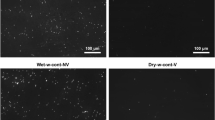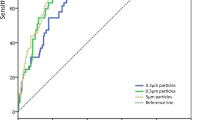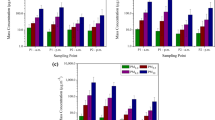Abstract
Portable microbial samplers are being increasingly used to determine the presence of microbial agents in the air; however, their performance characteristics when sampling airborne biological agents are largely unknown. In addition, it is unknown whether these samplers could be used to assess microbial inhalation exposure according to the particle sampling conventions. This research analyzed collection efficiencies of MAS-100, Microflow, SMA MicroPortable, Millipore Air Tester, SAS Super 180, BioCulture, and RCS High Flow portable microbial samplers when sampling six bacterial and fungal species ranging from 0.61 to 3.14 μm in aerodynamic diameter. The efficiencies with which airborne microorganisms were deposited on samplers’ collection medium were compared to the particle inhalation and lung deposition convention curves. When sampling fungi, RCS High Flow and SAS Super 180 deposited 80%–90% of airborne spores on agar — highest among investigated samplers. Other samplers showed collection efficiencies of 10%–60%. When collecting bacteria, RCS High Flow and MAS-100 collected 20%–30%, whereas other samplers collected less than 10% of these bioparticles. Comparison of samplers’ collection efficiencies with particle inhalation convention curves showed that RCS High Flow and SAS Super 180 could be used to assess inhalation exposure to particles larger than 2.5 μm, such as fungal spores. Performance of RCS High Flow sampler was also reflective of the particle lung deposition pattern when sampling both bacteria and fungi. MAS-100 and SAS Super 180 matched the total deposition curve fairly well when collecting bacterial and fungi species, respectively. For other tested samplers, we observed substantial discrepancies between their performances and particle deposition efficiencies in the lung. The results show that feasibility of applying portable microbial samplers for exposure assessment depends on a particular sampler model and microbial species.
This is a preview of subscription content, access via your institution
Access options
Subscribe to this journal
Receive 6 print issues and online access
$259.00 per year
only $43.17 per issue
Buy this article
- Purchase on Springer Link
- Instant access to full article PDF
Prices may be subject to local taxes which are calculated during checkout






Similar content being viewed by others
References
ACGIH. Particle size-selective sampling for particulate air contaminants, In: Vincent, J.H. (Ed.). American Conference for Governmental Industrial Hygienists 1999, Cincinnati, OH.
Aizenberg V., Reponen T., Grinshpun S.A., and Willeke K. Performance of Air-O-Cell, Burkard, and Button Samplers for total enumeration of airborne spores. Am Ind Hyg Assoc J 2000: 61: 855–864.
Baldwin P.E.J., and Maynard A.D. A survey of wind speeds in indoor workplaces. Ann Occup Hyg 1998: 20: 303–313.
Berry R.D., and Froude S. An investigation of wind conditions in the workplace to assess their effect on the quantity of dust inhaled 1998 Internal Report IR/L/DS/89/3. Health and Safety Executive, London.
Bholah R., and Subratty A.H. Indoor biological contaminants and symptoms of sick building syndrome in office buildings in Mauritius. Int J Environ Health Res 2002: 12: 93–98.
Centers for Disease Control and Prevention. Recommended infection-control practices for dentistry. MMWR 1993: 42, (No. RR-8) http://www.cdc.gov/mmwr/PDF/rr/rr4208.pdf.
Ciegler A. Fungi that produce mycotoxins: conditions and occurrence. Mycopathologia 1978: 65: 5–11.
Cooley J.D., Wong W.C., Jumper C.A., and Straus D.C. Correlation between the prevalence of certain fungi and sick building syndrome. J Occup Environ Med 1998: 55: 579–584.
Fang C.P., Marple V.A., and Rubow K.L. Influence of cross-flow on particle collection characteristics of multi-nozzle impactors. J Aerosol Sci 1991: 22: 403–415.
Górny R.L., Dutkiewicz J., and Krysinska-Traczyk E. Size distribution of bacterial and fungal bioaerosols in indoor air. Ann Agric Environ Med 1999: 6: 105–113.
Hill S.C., Pinnick R.G., Niles S., Pan Y.L., Holler S., Chang R.K., Bottiger J., Chen B.T., Orr C.S., Feather G., and Snyder A.P. Real-time measurement of fluorescence spectra from single airborne biological particles. Field Anal Chem Technol 1999: 3: 221–239.
Hinds W.C. Aerosol Technology: Properties, Behavior, and Measurement of Airborne Particles 1999, John Wiley & Sons, Inc, New York, NY.
ICRP. Human Respiratory Tract Model for Radiological Protection. International Commission on Radiological Protection, ICRP Publication 66, 1994, Elsevier Science, Tarrytown, NY.
Jurcik B., and Wang H.C. On the shape of impactor efficiency curves. J Aerosol Sci 1995: 26: 1139–1147.
Kenny L.C., Bowry A., Crook B., and Stancliffe J.D. Field testing of a personal size-selective bioaerosol sampler. Ann Occup Hyg 1999: 43: 393–404.
Kwon S.B., Kim M.C., and Lee K.W. Effects of jet configuration on the performance of multi-nozzle impactors. J Aerosol Sci 2002: 33: 859–869.
Macher J.M. Evaluation of bioaerosol sampler performance. J Occup Environ Med 1997: 12: 730–736.
Marple V.A., and Willeke K. Impactor design. Atmos Environ 1976: 10: 891–896.
Nevalainen A. Bacterial Aerosols in Indoor Air. Publications of the National Public Health Institute, Kuopio, Finland, 1989 pp 61–66.
Presley S.M., Rainwater T.R., Austin G.P., Platt S.G., Zak J.C., Cobb G.P., Marsland E.J., Tian K., Zhang B., Anderson T.A., Cox S.B., Abel M.T., Leftwich B.D., Huddleston J.R., Jeter R.M., and Kendall R.J. Assessment of pathogens and toxicants in New Orleans, LA following hurricane Katrina. Environ Sci Technol 2006: 40: 468–474.
Rhodes G.R., Rohatagi S., Gillen M.S., Deluccia F., Banerji D.D., and Chaikin P. In vitro and in vivo techniques used in drug development for evaluation of dose delivery of inhaled corticosteroids. J Clin Pharmacol 2001: 41: 7–18.
Roy C.J., and Thorne P.S. Exposure to particulates, microorganisms, β(1–3)-glucans, and endotoxins during soybean harvesting. Am Ind Hyg Assoc J 2003: 64: 487–495.
Teeuw K.B., Vandenbroucke-Grauls C.M., and Verhoef J. Airborne gram-negative bacteria and endotoxin in sick building syndrome. A study in Dutch governmental office buildings. Arch Intern Med 1994: 154: 2339–2345.
Trenter S.C., and Walmsley A.D. Ultrasonic dental scaler: associated hazards. J Clin Periodontol 2003: 30: 95–101.
Varma J.K., Greene K.D., Reller M.E., DeLong S.M., Trottier J., Nowicki S.F., DiOrio M., Koch E.M., Bannerman T.L., York S.T., Lambert-Fair M.A., Wells J.G., and Mead P.S. An outbreak of Escherichia coli O157 infection following exposure to a contaminated building. JAMA 2003: 290: 2709–2712.
Walinder R., Norback D., Wessen B., and Venge P. Nasal lavage biomarkers: effects of water damage and microbial growth in an office building. Arch Environ Health 2001: 56: 30–36.
Wouters I.M., Hilhorst S.K.M., Kleppe P., Doekes G., Douwes J., Peretz C., and Heederik D. Upper airway inflammation and respiratory symptoms in domestic waste collectors. Occup Environ Med 2002: 59: 106–112.
Yao M., and Mainelis G. Investigation of cutoff sizes and effective collection efficiencies of portable microbial samplers. Aerosol Sci Technol 2006: 40: 595–606.
Zacharisen M.C., Kadambi A.R., Schlueter D.P., Kurup V.P., Shack J.B., Fox J.L., Anderson H.A., and Fink J.N. The spectrum of respiratory disease associated with exposure to metal working fluids. Occup Environ Med 1998: 40: 640–647.
Zhiping W., Malmberg P., Larsson B.M., Larsson K., Larsson L., and Saraf A. Exposure to bacteria in swine-house dust and acute inflammatory reactions in humans. Am J Resp Crit Care Med 1996: 154: 1261–1266.
Acknowledgements
This publication was supported by grant DHHS-CDC1-K01-OH008029 from CDC/NIOSH. Its contents are solely the responsibility of the authors and do not necessarily represent the official views of the CDC/NIOSH. The technical assistance by EMD Chemicals, Inc. (Gibbstown, NJ), AP BUCK Inc. (Orlando, FL), Veltek Associates, Inc. (Phoenixville, PA), Bioscience International, Inc. (Rockville, MD), Millipore Corp. (Billerica, MA), and Biotest Diagnostics Corp. (Denville, NJ) is appreciated.
Author information
Authors and Affiliations
Corresponding author
Rights and permissions
About this article
Cite this article
Yao, M., Mainelis, G. Use of portable microbial samplers for estimating inhalation exposure to viable biological agents. J Expo Sci Environ Epidemiol 17, 31–38 (2007). https://doi.org/10.1038/sj.jes.7500517
Received:
Accepted:
Published:
Issue Date:
DOI: https://doi.org/10.1038/sj.jes.7500517
Keywords
This article is cited by
-
A novel method for measuring the charge distribution of airborne microbes
Aerobiologia (2011)



